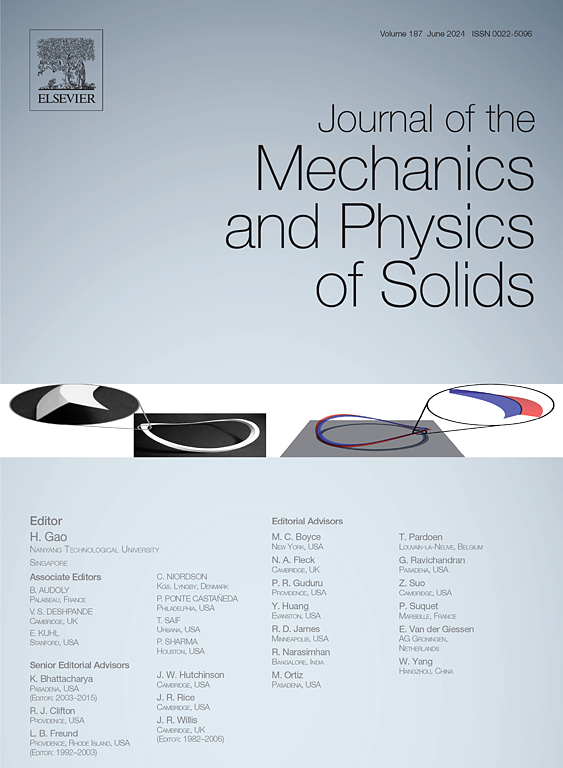Surface-polyconvex models for soft elastic solids
IF 6
2区 工程技术
Q2 MATERIALS SCIENCE, MULTIDISCIPLINARY
引用次数: 0
Abstract
Soft solids with surface energy exhibit complex mechanical behavior, necessitating advanced constitutive models to capture the interplay between bulk and surface mechanics. This interplay has profound implications for material design and emerging technologies. In this work, we set up variational models for bulk-surface elasticity and explore a novel class of surface-polyconvex constitutive models that account for surface energy while ensuring the existence of minimizers.
These models are implemented within a finite element framework and validated through benchmark problems and applications, including, e.g., the liquid bridge problem and the Rayleigh-Plateau instability, for which the surface energy plays the dominant role. The results demonstrate the ability of surface-polyconvex models to accurately capture surface-driven phenomena, establishing them as a powerful tool for advancing the mechanics of soft materials in both engineering and biological applications.
软弹性固体的表面-多凸模型
具有表面能的软固体表现出复杂的力学行为,需要先进的本构模型来捕捉体力学和表面力学之间的相互作用。这种相互作用对材料设计和新兴技术有着深远的影响。在这项工作中,我们建立了体-表面弹性的变分模型,并探索了一类新的表面-多凸本构模型,该模型在保证极小值存在的同时考虑了表面能。
本文章由计算机程序翻译,如有差异,请以英文原文为准。
求助全文
约1分钟内获得全文
求助全文
来源期刊
CiteScore
9.80
自引率
9.40%
发文量
276
审稿时长
52 days
期刊介绍:
The aim of Journal of The Mechanics and Physics of Solids is to publish research of the highest quality and of lasting significance on the mechanics of solids. The scope is broad, from fundamental concepts in mechanics to the analysis of novel phenomena and applications. Solids are interpreted broadly to include both hard and soft materials as well as natural and synthetic structures. The approach can be theoretical, experimental or computational.This research activity sits within engineering science and the allied areas of applied mathematics, materials science, bio-mechanics, applied physics, and geophysics.
The Journal was founded in 1952 by Rodney Hill, who was its Editor-in-Chief until 1968. The topics of interest to the Journal evolve with developments in the subject but its basic ethos remains the same: to publish research of the highest quality relating to the mechanics of solids. Thus, emphasis is placed on the development of fundamental concepts of mechanics and novel applications of these concepts based on theoretical, experimental or computational approaches, drawing upon the various branches of engineering science and the allied areas within applied mathematics, materials science, structural engineering, applied physics, and geophysics.
The main purpose of the Journal is to foster scientific understanding of the processes of deformation and mechanical failure of all solid materials, both technological and natural, and the connections between these processes and their underlying physical mechanisms. In this sense, the content of the Journal should reflect the current state of the discipline in analysis, experimental observation, and numerical simulation. In the interest of achieving this goal, authors are encouraged to consider the significance of their contributions for the field of mechanics and the implications of their results, in addition to describing the details of their work.

 求助内容:
求助内容: 应助结果提醒方式:
应助结果提醒方式:


